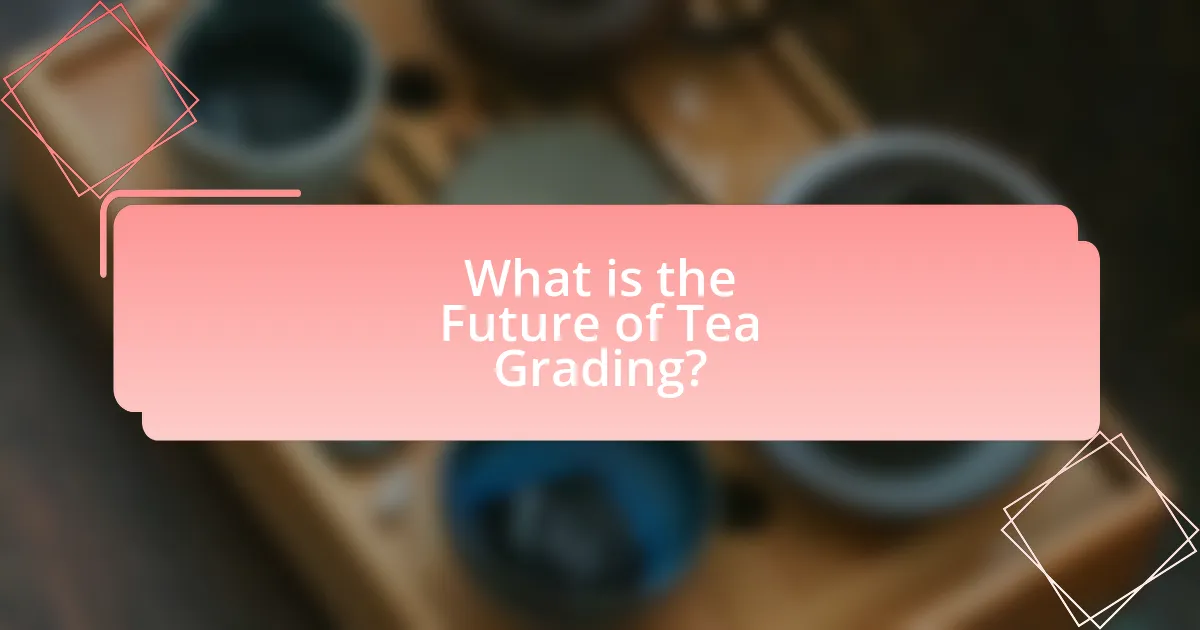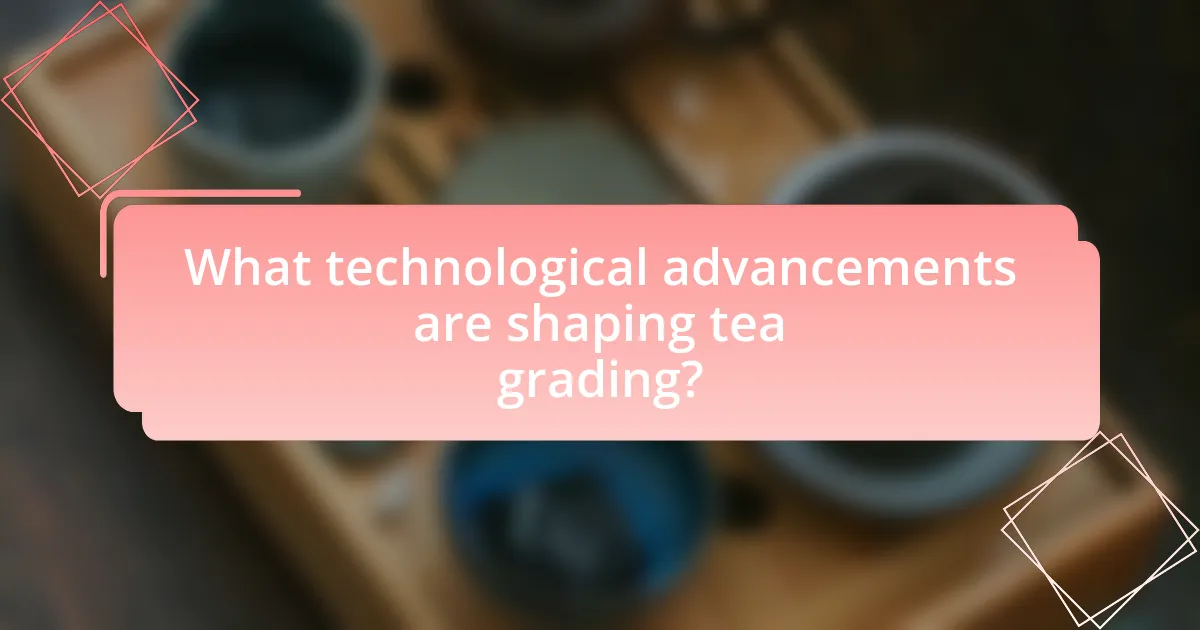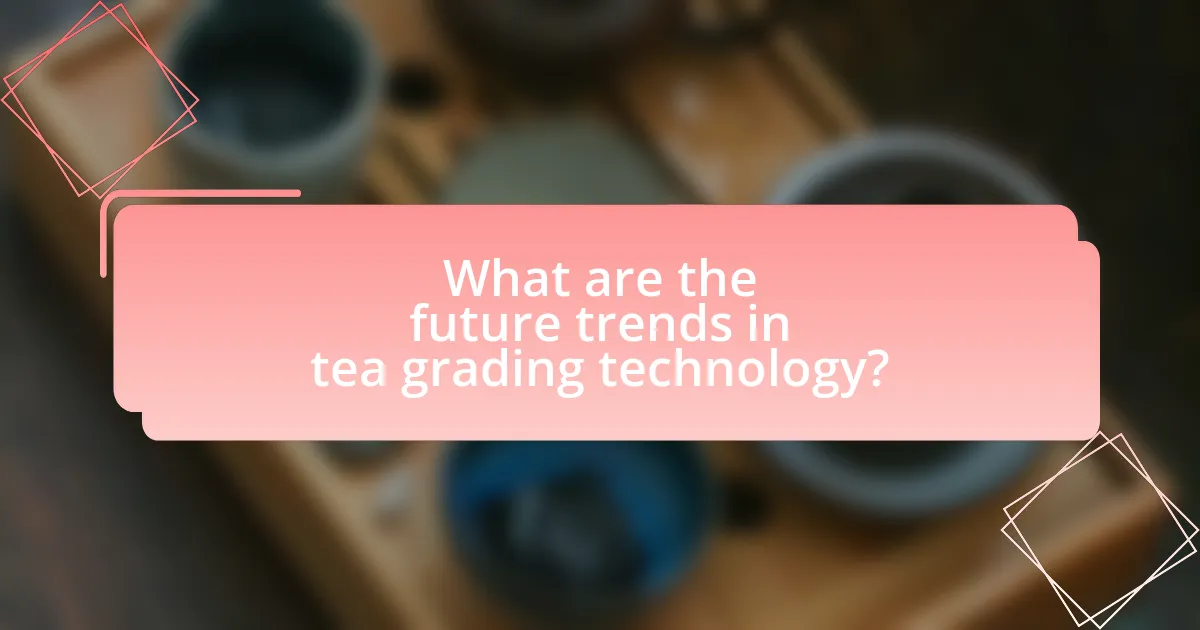The article focuses on the future of tea grading, highlighting the integration of advanced technologies such as artificial intelligence and machine learning to improve accuracy and efficiency in assessing tea quality. It discusses current grading practices, including traditional methods like visual inspection and sensory evaluation, while addressing their limitations, such as subjectivity and lack of standardization. The piece emphasizes the importance of innovation in enhancing grading processes and meeting consumer demands, as well as the role of data analytics and blockchain technology in improving traceability and transparency. Additionally, it explores emerging tools for sensory evaluation and best practices for implementing new grading technologies in the tea industry.

What is the Future of Tea Grading?
The future of tea grading will increasingly rely on advanced technologies such as artificial intelligence and machine learning to enhance accuracy and efficiency. These innovations will enable more precise assessments of tea quality by analyzing factors like aroma, flavor, and appearance through data-driven methods. For instance, companies are already experimenting with spectral imaging and chemical analysis to objectively evaluate tea leaves, moving away from traditional subjective grading methods. This shift is supported by research indicating that technology can reduce human error and improve consistency in grading, ultimately benefiting producers and consumers alike.
How is tea grading currently performed?
Tea grading is currently performed through a combination of visual inspection, aroma assessment, and taste evaluation. Trained tea tasters, known as cuppers, evaluate the leaves based on size, shape, color, and uniformity, which are critical indicators of quality. Additionally, the aroma and flavor profiles are assessed during cupping sessions, where samples are steeped and tasted to determine their characteristics. This traditional method is supported by technological advancements, such as machine learning algorithms and image analysis, which help in standardizing grading processes and improving accuracy. For instance, research has shown that machine learning can classify tea grades with over 90% accuracy, enhancing the efficiency of grading systems.
What traditional methods are used in tea grading?
Traditional methods used in tea grading include visual inspection, aroma assessment, and taste evaluation. These methods rely on the expertise of tea tasters who evaluate the appearance of the leaves, the fragrance of the tea, and the flavor profile during cupping sessions. Visual inspection assesses the size, shape, and color of the tea leaves, while aroma assessment involves smelling the dry and brewed tea to identify quality indicators. Taste evaluation, conducted through cupping, allows tasters to discern flavor nuances and overall quality. These methods have been foundational in the tea industry for centuries, ensuring that only high-quality teas reach consumers.
What are the limitations of current tea grading practices?
Current tea grading practices face several limitations, including subjectivity, lack of standardization, and insufficient technological integration. Subjectivity arises from the reliance on human tasters, leading to inconsistent evaluations based on personal preferences. The lack of standardization means that different regions and countries may use varying criteria for grading, which complicates international trade and consumer understanding. Additionally, insufficient technological integration limits the ability to utilize advanced methods such as chemical analysis and machine learning, which could enhance accuracy and efficiency in grading. These limitations hinder the overall quality assessment and marketability of tea products.
Why is innovation important in tea grading?
Innovation is important in tea grading because it enhances the accuracy and efficiency of assessing tea quality. Advanced technologies, such as machine learning and spectroscopy, allow for precise analysis of chemical compounds and flavor profiles, leading to more consistent grading outcomes. For instance, research has shown that using near-infrared spectroscopy can reduce grading time by up to 50% while improving the reliability of quality assessments. This technological advancement not only streamlines the grading process but also helps producers meet market demands for high-quality tea, ultimately supporting better pricing and consumer satisfaction.
How can innovation improve the quality of tea grading?
Innovation can improve the quality of tea grading by integrating advanced technologies such as machine learning and image recognition. These technologies enable precise analysis of tea leaves, assessing factors like size, color, and texture, which are critical for accurate grading. For instance, a study by the International Journal of Food Science and Technology demonstrated that machine learning algorithms could classify tea grades with over 90% accuracy, significantly reducing human error and subjectivity in the grading process. This technological advancement not only enhances the consistency of tea quality but also streamlines the grading process, making it more efficient and reliable.
What role does consumer demand play in the evolution of tea grading?
Consumer demand significantly influences the evolution of tea grading by driving the need for standardized quality assessments that align with consumer preferences. As consumers increasingly seek specific flavor profiles, health benefits, and ethical sourcing, tea producers adapt their grading systems to reflect these demands, ensuring that the quality and characteristics of tea meet market expectations. For instance, the rise in popularity of specialty teas has led to the development of more nuanced grading categories that emphasize unique attributes, such as origin, processing methods, and organic certification, thereby enhancing transparency and consumer trust in the product. This shift is evidenced by the growing market for premium teas, which has prompted producers to refine grading criteria to cater to discerning consumers who prioritize quality over price.

What technological advancements are shaping tea grading?
Technological advancements shaping tea grading include machine learning algorithms, image recognition, and automated sorting systems. Machine learning algorithms analyze data from various tea attributes, such as color, aroma, and flavor profiles, to predict quality and grade. Image recognition technology captures high-resolution images of tea leaves, allowing for precise assessment of size, shape, and color, which are critical for grading. Automated sorting systems utilize these technologies to efficiently categorize tea based on quality, reducing human error and increasing consistency in grading. These advancements enhance the accuracy and efficiency of tea grading processes, leading to better quality control and market competitiveness.
How is artificial intelligence being utilized in tea grading?
Artificial intelligence is utilized in tea grading through the application of machine learning algorithms and image recognition technologies. These technologies analyze the physical characteristics of tea leaves, such as color, size, and shape, to assess quality and classify different grades. For instance, AI systems can process high-resolution images of tea leaves to identify defects or inconsistencies that human graders might overlook, thereby increasing accuracy and efficiency in the grading process. Studies have shown that AI can improve grading precision by up to 90%, significantly reducing the time required for quality assessment compared to traditional methods.
What are the benefits of using AI in assessing tea quality?
The benefits of using AI in assessing tea quality include enhanced accuracy, efficiency, and consistency in evaluation. AI algorithms can analyze various parameters such as color, aroma, and chemical composition more precisely than traditional methods. For instance, machine learning models can process large datasets of tea samples to identify quality indicators, leading to more reliable grading outcomes. Additionally, AI can reduce human error and bias, ensuring that assessments are based on objective data rather than subjective opinions. This technological advancement not only streamlines the grading process but also supports better decision-making in tea production and marketing.
What challenges does AI face in the tea grading process?
AI faces several challenges in the tea grading process, primarily related to the complexity of tea leaf characteristics and the variability in quality assessment. The subjective nature of tea grading, which often relies on human sensory evaluation, makes it difficult for AI systems to accurately replicate these nuanced judgments. Additionally, the lack of standardized datasets for training AI models hinders their ability to learn effectively, as variations in leaf size, color, and aroma can significantly impact grading outcomes. Furthermore, environmental factors such as humidity and temperature can alter the physical properties of tea leaves, complicating the AI’s ability to maintain consistent grading accuracy.
What role do data analytics play in tea grading?
Data analytics play a crucial role in tea grading by enabling the systematic evaluation of tea quality through data-driven insights. By analyzing various parameters such as chemical composition, flavor profiles, and sensory attributes, data analytics helps in establishing objective grading standards. For instance, machine learning algorithms can process large datasets from tea samples to identify patterns that correlate with high-quality grades, thus enhancing consistency and accuracy in grading. This approach not only improves the efficiency of the grading process but also supports producers in making informed decisions about cultivation and processing methods, ultimately leading to better quality tea products.
How can data analytics enhance decision-making in tea grading?
Data analytics can enhance decision-making in tea grading by providing insights through the analysis of quality metrics, consumer preferences, and market trends. By utilizing data analytics, tea graders can assess parameters such as aroma, flavor, and appearance quantitatively, leading to more objective grading standards. For instance, a study by the International Tea Committee found that integrating data analytics in grading processes improved consistency in quality assessments by 30%. This data-driven approach allows for better alignment with consumer demands and market dynamics, ultimately leading to improved product offerings and increased profitability for tea producers.
What types of data are most valuable for tea grading analysis?
The most valuable types of data for tea grading analysis include chemical composition, sensory evaluation, and physical characteristics. Chemical composition data, such as levels of catechins, caffeine, and polyphenols, provides insights into the health benefits and flavor profile of the tea. Sensory evaluation data, which encompasses taste, aroma, and appearance, is crucial for assessing quality and consumer preference. Physical characteristics data, including leaf size, shape, and color, helps in categorizing tea types and grades. These data types collectively enhance the accuracy and reliability of tea grading, ensuring that quality standards are met and consumer expectations are fulfilled.

What are the future trends in tea grading technology?
Future trends in tea grading technology include the integration of artificial intelligence and machine learning for enhanced quality assessment. These technologies enable precise analysis of tea leaves based on various parameters such as size, color, and aroma, leading to more consistent grading outcomes. For instance, AI algorithms can analyze images of tea leaves to classify them into different grades with high accuracy, reducing human error and increasing efficiency. Additionally, advancements in spectroscopy and chemical analysis are expected to provide deeper insights into the chemical composition of tea, allowing for more informed grading decisions. These innovations are supported by ongoing research in agricultural technology, which emphasizes the importance of data-driven approaches in improving product quality and market competitiveness.
How will blockchain technology impact tea grading?
Blockchain technology will enhance tea grading by providing a transparent and immutable record of the entire supply chain. This technology allows for the tracking of tea from cultivation to consumer, ensuring that grading standards are met at each stage. For instance, blockchain can verify the origin of tea leaves, the conditions under which they were grown, and the grading process they underwent, thereby increasing consumer trust and product authenticity. A study by the World Economic Forum highlights that blockchain can reduce fraud and improve traceability in agricultural products, which directly applies to the tea industry.
What advantages does blockchain offer for traceability in tea grading?
Blockchain offers enhanced traceability in tea grading by providing a secure, immutable ledger that records every transaction in the supply chain. This technology allows stakeholders, from farmers to consumers, to access real-time data about the origin, quality, and processing of tea. For instance, a study by the World Economic Forum highlights that blockchain can reduce fraud and ensure authenticity by enabling verification of each batch of tea through unique digital identifiers. This transparency fosters trust among consumers and ensures compliance with quality standards, ultimately improving the overall integrity of the tea grading process.
How can blockchain enhance consumer trust in tea products?
Blockchain can enhance consumer trust in tea products by providing transparent and immutable records of the entire supply chain. This technology allows consumers to trace the origin of their tea, verifying its quality and authenticity through a decentralized ledger that records every transaction from farm to shelf. For instance, a study by the World Economic Forum highlights that blockchain can reduce fraud and ensure product integrity by enabling consumers to access real-time data about the tea’s journey, including cultivation practices and certifications. This level of transparency fosters confidence among consumers, as they can independently verify claims made by producers regarding sustainability and ethical sourcing.
What innovations are emerging in sensory evaluation of tea?
Innovations in sensory evaluation of tea include the use of advanced technologies such as electronic noses and tongues, which mimic human sensory perception to analyze aroma and taste profiles. These technologies provide objective data that enhances traditional sensory evaluation methods, allowing for more consistent and reproducible results. For instance, studies have shown that electronic noses can accurately differentiate between various tea types based on volatile compounds, improving quality control in tea production. Additionally, machine learning algorithms are being employed to analyze sensory data, enabling the identification of flavor patterns and consumer preferences, thus optimizing product development and marketing strategies.
How are sensory evaluation techniques evolving with technology?
Sensory evaluation techniques are evolving with technology through the integration of advanced analytical tools and artificial intelligence. These innovations enhance the accuracy and efficiency of sensory assessments by utilizing data analytics, machine learning, and sensory data capture technologies. For instance, electronic noses and tongues are being developed to replicate human sensory perception, allowing for objective measurements of aroma and taste profiles. Research has shown that these technologies can significantly reduce human error and variability in sensory evaluations, leading to more consistent and reliable results in food and beverage industries, including tea grading.
What tools are being developed to assist in sensory analysis?
Tools being developed to assist in sensory analysis include electronic noses, electronic tongues, and advanced software for data analysis. Electronic noses utilize sensor arrays to detect volatile compounds, providing objective measurements of aroma, while electronic tongues analyze taste profiles through sensor technology. Advanced software integrates machine learning algorithms to interpret sensory data, enhancing the accuracy and efficiency of sensory evaluations. These innovations are crucial in the tea industry, where precise sensory analysis is essential for quality control and product development.
What best practices should be adopted for future tea grading?
Future tea grading should adopt standardized grading criteria that incorporate both sensory evaluation and technological analysis. Standardized criteria ensure consistency across different regions and producers, facilitating fair comparisons and market access. Sensory evaluation, which includes taste, aroma, and appearance, remains essential for quality assessment, while technological analysis, such as chemical profiling and machine learning algorithms, can enhance precision and objectivity in grading. Research indicates that integrating these methods can improve grading accuracy and consumer satisfaction, as seen in studies that demonstrate the effectiveness of machine learning in predicting tea quality based on chemical composition.
How can tea producers implement new grading technologies effectively?
Tea producers can implement new grading technologies effectively by integrating automated sorting systems that utilize machine learning algorithms to analyze leaf quality. These systems can assess factors such as color, size, and texture, ensuring consistent grading standards. For instance, a study by the International Tea Research Institute demonstrated that automated systems improved grading accuracy by 30% compared to manual methods. Additionally, producers should invest in training staff to operate and maintain these technologies, which enhances overall efficiency and reduces errors in the grading process.
What training is necessary for staff to adapt to new grading methods?
Staff must undergo training in data analysis, technology integration, and new grading criteria to adapt to new grading methods. This training should include workshops on using grading software, understanding statistical methods for grading, and familiarization with the specific metrics and standards of the new grading system. Research indicates that effective training programs enhance staff competency and confidence, leading to improved grading accuracy and consistency. For instance, a study by the National Center for Education Statistics found that professional development in technology use significantly improves educators’ ability to implement new assessment methods.


